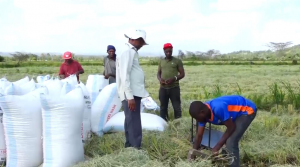Being the third main cereal crop grown in Kenya after maize and wheat, rice farming has steadily gained popularity in some parts of Murang’a County.
Over the years, rice has been grown in established irrigation schemes like Ahero, Bunyala, West Kano, and central Kenya’s Mwea scheme in Kirinyaga County.
However, in some parts of Gaturi in the Kiharu constituency, one does not fail to notice tens of rice paddies decorating the farms in a venture that residents have optimistically embraced farming the cereal.
The area is also susceptible to seasonal flooding, and through trial and error, the idea of planting rice was birthed.
Additionally, on the highway, as one heads towards Mukurueni, Nyeri County rice traders strategically place sacks of rice on the sidewalks, awaiting buyers, and one can foresee a booming business in years to come.
John Mwangi, 45, is one of the farmers who quit maize and bean farming in 2020 and has been growing rice on his two-acre piece of land.
He divulges that they noted people from other areas had leased pieces of land around and planted rice, which was doing well. This motivated him to also venture into rice farming.
“They were reaping huge returns, and I got interested in the venture as well. I quit planting maize and beans, which were no longer tenable.” He observes
Rice crops are versatile and can grow in a range of soil types, from sandy loam to silty loam, require irrigation, and can survive flooding. The crop also requires a soil pH varying from 5.0 to 9.0.
“This area was connected with water for irrigation by the county government back in 2016, and this has improved our livelihoods through farming, even though currently the water is not enough, “says Mwangi as he pokes the ground, exposing a dry patch.
Preparations of land to plant rice, which can grow from 3.3 feet to 5.9 feet tall, involve ploughing and harrowing to till and level the soil.
The farmers have learnt from the pacesetters in rice growing and find it easier to prepare the land by employing the services of combine harvesters from the Mwea irrigation scheme.
“They till the land for us, thus reducing hours used in manpower, and when the rice is ready, we again use mechanised harvesting.” Says Cyrus Kamau, adding that, After transplanting the rice, one has to spray and check out for weeds and parasites and keep weaver birds away. Rice matures in four to five months.
Admittedly, from his one-acre piece of land, Mwangi harvested 60 sacks of 50 kilograms of rice against the ideal 30 sacks that most of the time are harvested from one acre of land.
This venture is, however, not without challenges.
“Our greatest challenge is snails and birds invading the farms that end up destroying our crop,” says Mary Muthoni, also a rice farmer.
She urges the government to also ensure they get access to pesticides and other farm inputs at a subsidised cost because currently the cost of these vital inputs is too high, thus lowering their return on investment.
The farmers have also called on the county government to ensure they are connected to enough water for irrigation as they venture into rice farming, as it is very lucrative and the market is still underutilised.
Locals have also been advised to consider venturing into rice farming, as rice is widely consumed, is easy to grow and manage, and has good returns as long as there is enough water.
By Florence Kinyua










